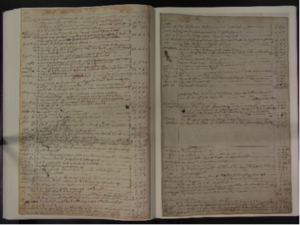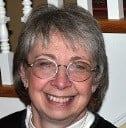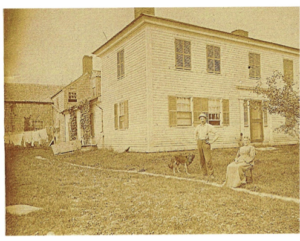Shortly after the Covid-19 stay-at-home order was implemented in Maine, Son remarked that living in My Old House, now known as Our Old House, is like living in two centuries at once, the eighteenth, nineteenth, or twentieth centuries – as well as the twenty-first.
In the eighteenth century, when this house was built, my ancestors’ daily lives as farmers were “at home.” Now, as the prodigal farmers’ daughter living in their house during the Covid-19 pandemic, I’ve planted a small garden and signed on with local farmers for the vegetables, dairy, and meat supplies I either decline to produce on my own or lack the wherewithal to grow. (I gave up mucking out the barn decades ago, and no one wants me near a garden plow. I confess that I do occasionally have an attack of “tractor envy” as I drive by the neighborhood tractor dealer.) Son has hand-dug a garden bed for growing corn, hoping that we can get it fenced in before the turkeys and woodchuck find it. He was also grateful that my great-grandfather’s spade and shovel are long gone; Grampa’s edger, however, broke at the second row.
Finally.
 Asa Williams account, S. & W. Howard Store. Courtesy Linda Novak, Director/Curator, Old Fort Western
Asa Williams account, S. & W. Howard Store. Courtesy Linda Novak, Director/Curator, Old Fort Western
Fort Western was the supermarket and bank of the eighteenth century and into the nineteenth, with the Fort’s trading post and then the S. & W. Howard Store. Trading was the business of the time because most people in the Fort Western settlement were more self-sufficient than we are today. While Our Old House builder, Asa Williams, borrowed money from the trading post owner to buy this property, he and the rest of the family did very little trading or banking there, according to the Howard Account Books.
I still feel that the nineteenth century is alive and well here as I try to cool Our Old House on this hottest day yet this year. The house was built with horsehair lathe and plaster walls, occasionally lined with newspaper for insulation (even over the fireplaces!), none of which were especially effective in keeping out heat or cold. In the late 1800s, Charles and Harriett Saunders, my cousins and House owners at the time, tried to keep the upstairs cooler by closing the window shutters. Personal note here: Those darned shutters do nothing but make the room dark! Enter modern window air conditioners (forced into eighteenth-century windows with herculean effort) and comfortable nights of lovely sleep. The shutters now are purely decorative, as they should be (but still a pain to paint).
[It] wasn’t until the very early 1940s that a bathroom was added to Our Old House.
In times of illness, epidemic or not, a bathroom is usually considered critical. Yet it wasn’t until the very early 1940s that a bathroom was added to Our Old House. Another cousin who lived here with her grandmother in 1938 remembers having to walk through the house and forge buildings to the outhouses. (Note the plural; how pretentious!) I am delighted that by the time I came along a basic bathroom occupied a place of prominence just off the kitchen, instead of “out back.”
Face masks aren’t new, either. While great-great-great-great-grandfather undoubtedly used a piece of cloth as a dust mask, bandana style, while he made his own bricks, we have surgical-style masks in a variety of fabrics and colors. Nonetheless, Husband still looks like a bank robber with his black hoodie, black t-shirt, and black sunglasses over a light blue surgical mask. I’m hoping I won’t need the name of a good bail commissioner!
Sanitizing everything now is my new normal. At least I have modern disinfectants to use instead of the sulfur or mercury of previous centuries. However, lime was still in use during my childhood at Our Old House as well as at the neighbors’ farms as whitewash, cattle feed, and insect repellent. I lived, anyway.
When illness, epidemics or otherwise, have appeared (such as plague, yellow fever, scarlet fever, cholera, typhoid, Spanish Flu, diphtheria, polio, measles, or coronavirus), this Old House has stood and still stands witness to the continuation of daily life even as the current contagion spreads through the community. We stay at home, just as my ancestors did in their usual daily lives. We continue to maintain the property and try to become as self-sufficient as possible, just as they did. We now can more fully appreciate the bounty that we have. We enjoy our fields and woods with its wildlife (woodchuck notwithstanding – he/she is under the garage), cherry and apple trees as well as the black walnut trees, the lawns that always need mowing, flower beds that need continual weeding, and a house that will always be very old.
We stay at home, just as my ancestors did in their usual daily lives. We continue to maintain the property and try to become as self-sufficient as possible, just as they did.
Electrical power, the internet, social media, television – all things totally foreign to my forebears – make our daily chores easier if not effortless, and our isolation less “isolating” than it would have been without those amenities. My paternal grandmother, who started life with horse-drawn wagons and handwritten stationery letters and who lived through epidemics and wars, would marvel at Zoom. She was always happy to have a TV so she could watch the Red Sox games, but she had to listen on the radio (the wireless!) when her team won the 1918 World Series!
The current pandemic has helped me to more fully understand and appreciate how my ancestors, including my parents, lived in this house, and how their efforts to maintain their property have given me what I have today: home, a place to be comfortable, a place to be safe from whatever is out there that wants to kill me.
It proves one thing to me: the more things change, the more they stay the same.
Share this:

About Jan Doerr
Jan Doerr received a B.A. degree in Sociology/Secondary Education from the University of New Hampshire, and spent a long career in the legal profession while researching her family history. She has recently written and published articles for WBUR.org’s Cognoscenti blog: “Labor of Love: Preserving a 226-Year-Old Family Home and Preparing to Let It Go” and “The Value of Family Heirlooms in a Digital Age.” Jan currently lives with her attorney husband in Augusta, Maine, where she serves two Siamese cats and spends all her retirement money propping up a really old house.View all posts by Jan Doerr →
